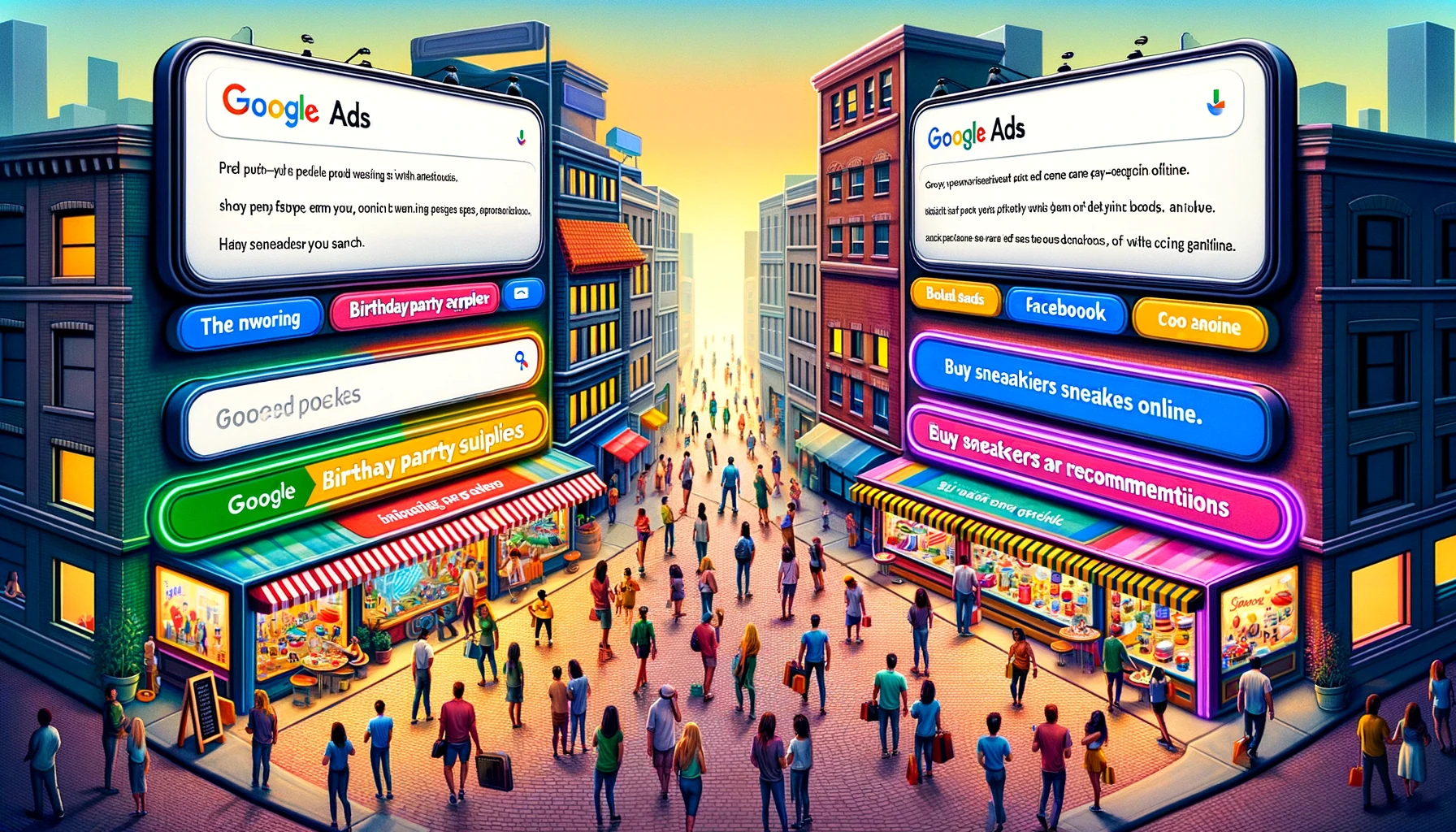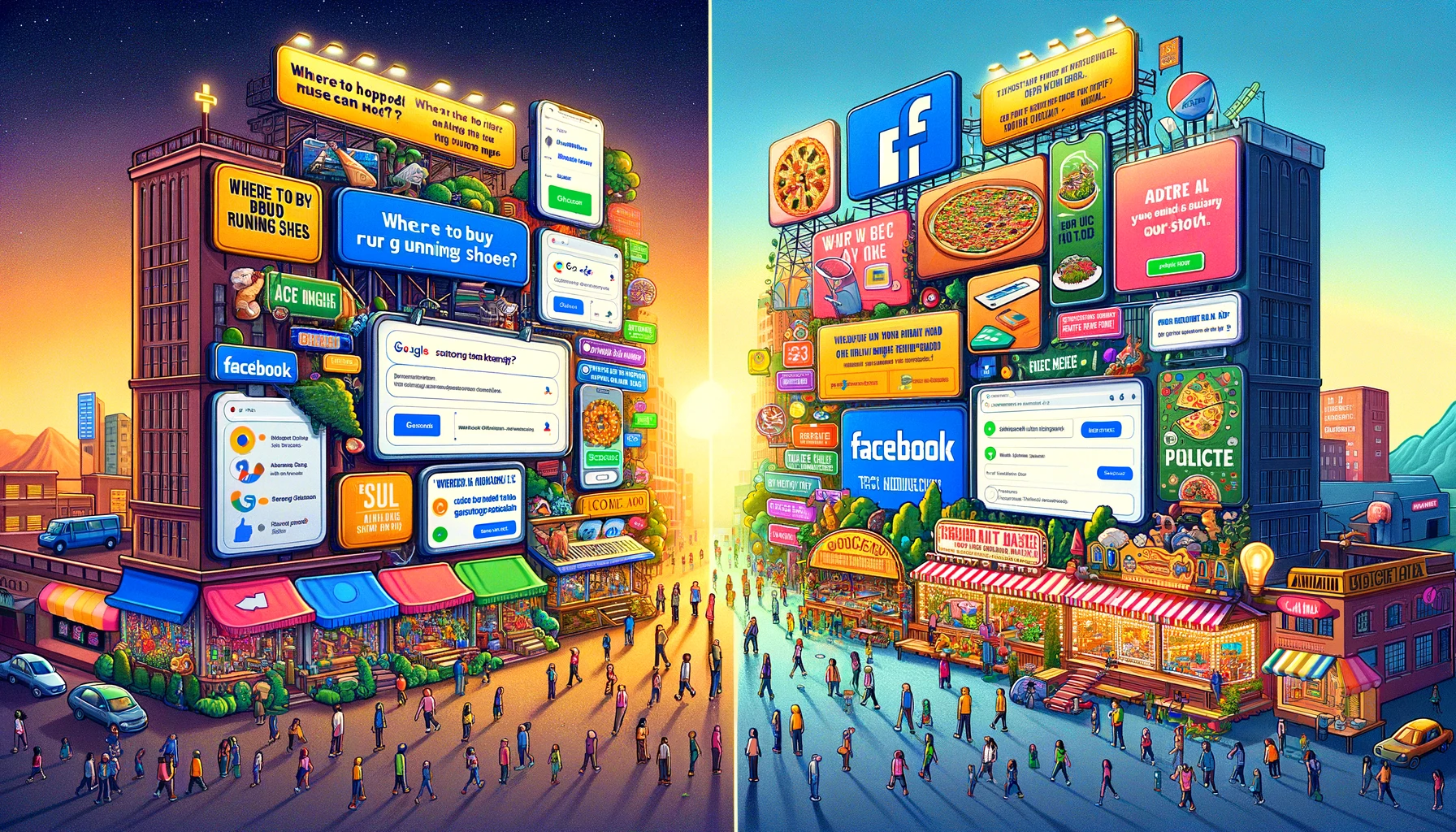Understanding Facebook and Google Ads
When you dive into the world of online advertising, you’ll find two giants waiting for you: Facebook and Google. Each platform offers unique advantages and operates in its own special way. Let’s get to know them a little better.
Overview of Facebook Ads
Imagine you’re at a huge party, chatting with friends, sharing stories, and suddenly, you see a flyer about a cool new toy. That’s Facebook Ads for you. It’s like a smart friend who knows exactly what you might like and shows it to you while you’re having fun. Facebook Ads doesn’t wait for you to ask; it tells you what you might need or like based on what it knows about your interests. You’re there to connect with friends, scroll through photos, and maybe watch some funny videos. Amidst all this, Facebook Ads gently nudges products and services your way, hoping to catch your interest based on what you like and do on the platform.
Overview of Google Ads
Now, picture yourself walking into a giant library with a question in mind. You ask the librarian, and boom, you get a list of books answering your question. Google Ads works like this super helpful librarian. It’s all about intent. You type something into Google because you’re looking for answers, products, or services. Google Ads sees this and shows you ads that directly answer your query. It’s straightforward and intent-based. If you’re searching for “birthday party supplies,” Google Ads will show you ads from stores where you can buy balloons, decorations, and more.
In summary, Facebook Ads is like a friend who suggests something you might like during a conversation, while Google Ads is like a librarian who gives you exactly what you’re looking for when you ask for it. Both have their strengths, and understanding these can help you choose the right platform for your advertising needs.

The Intent Behind the Platforms
In the vast universe of online advertising, understanding the intent behind the platforms you choose can make all the difference in the world. Let’s take a closer look at Google Ads and Facebook Ads to understand their core intent and how they cater to different needs.
How Google Ads Works: Intent-Based Advertising
Imagine someone with a question or need, like finding a place to buy birthday party supplies. They go straight to Google and type it in. Google Ads is like a magic mirror that reflects exactly what they’re looking for in the form of ads. This platform is all about intent. When people search on Google, they have a clear intent. They’re on a mission to find something specific, and Google Ads helps businesses show up right at that moment of need. It’s direct, it’s focused, and it’s powerful for driving sales when someone is ready to buy.
How Facebook Ads Works: Audience-Based Advertising
Now, picture a different scene. Someone scrolling through Facebook, catching up with friends, laughing at memes, and suddenly, they see an ad for something that catches their eye. They weren’t looking for it, but it looks interesting. Facebook Ads is all about audience. It doesn’t wait for you to ask; instead, it uses what it knows about your likes, interests, and activities to show you ads that you might like. This way, Facebook Ads introduces you to products and services while you’re enjoying your social time, making discoveries based on what you’re likely to be interested in.
Both Google Ads and Facebook Ads have their place in the digital marketing landscape. Understanding the intent behind each platform allows marketers to tailor their strategies and reach their audience in the most effective way possible. Whether it’s capturing someone at the moment they’re ready to make a purchase or introducing them to something new that aligns with their interests, choosing the right platform based on intent can significantly impact the success of your advertising efforts.
Case Scenarios: Where Each Platform Excels
In the realm of digital marketing, both Google Ads and Facebook Ads have their stages where they shine the brightest. Let’s explore the settings where each platform takes the spotlight.
When to Use Google Ads
Picture yourself in a bustling city, surrounded by signs that answer your every question. You’re on a quest for the perfect pair of running shoes, and right there, amidst the urban hustle, a billboard points you to the nearest store. This is Google Ads at its best—when people know what they want and are actively searching for it. It’s for those moments of immediate need or curiosity:
- Searching for a local service, like the best pizza delivery.
- Looking for a specific item, such as running shoes or tech gadgets.
- Seeking answers to specific questions, where intent is clear and purchase-ready.
Google Ads is the go-to when you want to capture the attention of someone who’s already on the lookout for what you offer, making it a powerful ally for direct sales and lead generation.
When to Use Facebook Ads
Now, imagine stepping into a vibrant community fair. There’s a buzz in the air, with stalls and booths draped in colorful banners, each sharing something unique—from the latest tech gadgets to handmade garden tools. This is where Facebook Ads shines—connecting with people based on their interests, activities, and the communities they belong to. It’s ideal for:
- Introducing a new product that revolutionizes an everyday task.
- Building brand awareness among audiences that share specific interests, like beauty, fitness, or technology.
- Engaging with potential customers by sharing stories, insights, and valuable content that resonates with their lifestyle.
Facebook Ads thrives on creating connections and nurturing relationships with your audience over time, making it perfect for broadening your reach and cultivating a community around your brand.
Both Google Ads and Facebook Ads offer unique advantages, and the choice between them depends on your marketing goals, the nature of your product or service, and the journey you want to take your customers on. By understanding where each platform excels, you can craft a marketing strategy that leverages the strengths of both, guiding your audience from discovery to decision with finesse.

Crafting Effective Campaigns on Both Platforms
To make the most out of your online advertising efforts, it’s crucial to understand how to craft effective campaigns on both Google Ads and Facebook Ads. Each platform requires a unique approach to connect with your audience and achieve your marketing goals.
Tips for Google Ads Success
- Keyword Optimization: Start by researching and selecting the right keywords. These are the words or phrases that people type into Google when they’re looking for something. Your ads should match these intentions as closely as possible.
- Ad Relevance: Make sure your ads are directly relevant to the keywords you bid on. This not only improves your chances of winning the bid but also ensures that people find exactly what they’re looking for when they click on your ad.
- Landing Page Experience: Once someone clicks on your ad, the page they land on should fulfill what was promised in the ad. It should be easy to navigate, informative, and, most importantly, make it easy for them to take the next step, whether that’s making a purchase or signing up for more information.
- Use Ad Extensions: Ad extensions provide additional information and ways for potential customers to interact with your ad. This can include contact info, links to specific parts of your website, or even product images.
Tips for Facebook Ads Success
- Target Audience: One of Facebook Ads’ biggest strengths is its ability to target ads based on demographics, interests, behaviors, and more. Spend time defining your ideal audience to ensure your ads are seen by the right people.
- Engaging Content: Create ads that tell a story or offer something valuable. This could be an entertaining video, an informative blog post, or an attractive offer. The goal is to engage people, not just sell to them.
- Visual Appeal: Use high-quality images or videos to catch the eye of your audience. Facebook is a visually driven platform, so your ad needs to stand out in a crowded feed.
- Test and Learn: Facebook offers extensive tools for A/B testing. Use them to try out different ad formats, images, headlines, and calls to action to see what works best with your audience.
By understanding the unique aspects of each platform and following these tips, you can craft effective campaigns that reach your audience in meaningful ways. Whether you’re aiming for direct sales through Google Ads or building brand awareness and engagement with Facebook Ads, the key is to tailor your approach to fit the strengths and opportunities of each platform.
Making the Right Choice for Your Business
Deciding between Google Ads and Facebook Ads is like choosing between two paths to reach your destination. Each path has its own set of landmarks, challenges, and rewards. Your choice should be guided by your business goals, target audience, and the kind of journey you want to take your customers on.
Assessing Your Marketing Goals
First, consider what you want to achieve with your advertising efforts. If your goal is to drive immediate sales or leads from people who are actively searching for products or services like yours, Google Ads might be the right path. It’s perfect for reaching users who have a clear intent and are ready to make a decision.
On the other hand, if your aim is to build brand awareness, engage a broader audience, or promote content that educates and entertains, then Facebook Ads could be your trail. It allows you to create connections, foster community, and gently guide your audience toward making a purchase over time.
Budget Considerations
Your budget is your backpack for the journey—it needs to be distributed wisely to keep you moving. Google Ads often involves bidding for keywords, which can be competitive and pricey, but it’s highly effective for targeting specific intents. Facebook Ads can be a more cost-effective way to reach a larger audience, especially if you’re aiming to spread the word rather than convert at the moment of search.
Final Recommendations
The choice isn’t always straightforward. Sometimes, the best strategy involves using both platforms to their strengths. Google Ads can capture the demand when customers are ready to purchase, while Facebook Ads can create the demand by raising awareness and building interest.
Consider your business’s destination, the journey you want to provide for your customers, and the resources you have available. By aligning these elements with the unique advantages of Google Ads and Facebook Ads, you’ll be able to choose the path that leads to success for your business.
In the decision-making landscape, standing at the crossroads with a compass in hand, the right choice becomes clearer when you know where you want to go. Whether you choose the mountain peak of intent-based marketing with Google Ads or the lush valley of audience engagement with Facebook Ads, both paths are paved with opportunities for growth and success.
